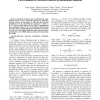Free Online Productivity Tools
i2Speak
i2Symbol
i2OCR
iTex2Img
iWeb2Print
iWeb2Shot
i2Type
iPdf2Split
iPdf2Merge
i2Bopomofo
i2Arabic
i2Style
i2Image
i2PDF
iLatex2Rtf
Sci2ools
133
Voted
ICPR
2010
IEEE
2010
IEEE
A Re-evaluation of Pedestrian Detection on Riemannian Manifolds
Abstract--Boosting covariance data on Riemannian manifolds has proven to be a convenient strategy in a pedestrian detection context. In this paper we show that the detection performances of the state-of-the-art approach of Tuzel et al. [7] can be greatly improved, from both a computational and a qualitative point of view, by considering practical and theoretical issues, and allowing also the estimation of occlusions in a fine way. The resulting detection system reaches the best performance on the INRIA dataset, setting novel state-of-theart results. Keywords-Pedestrian Detection, Riemaniann Manifolds, Boosting In Computer Vision, detecting people in images is a crucial yet hard task; this is due to the presence of many acquisition settings and the large variations of human appearance and pose. Across the many nowadays techniques, whose recent samples are [6], [7], [8], the ensemble-offeatures based methods [3], [7] are very promising. They are based on boosting [4], which is reckoned t...
| Added | 12 Feb 2011 |
| Updated | 12 Feb 2011 |
| Type | Journal |
| Year | 2010 |
| Where | ICPR |
| Authors | Diego Tosato, Michela Farenzena, Marco Cristani, Vittorio Murino |
Comments (0)

